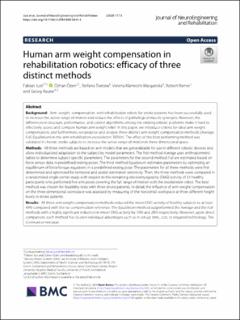Please use this identifier to cite or link to this item:
https://doi.org/10.21256/zhaw-19668| Publication type: | Article in scientific journal |
| Type of review: | Peer review (publication) |
| Title: | Human arm weight compensation in rehabilitation robotics : efficacy of three distinct methods |
| Authors: | Just, Fabian Özen, Özhan Tortora, Stefano Klamroth-Marganska, Verena Riener, Robert Rauter, Georg |
| et. al: | No |
| DOI: | 10.1186/s12984-020-0644-3 10.21256/zhaw-19668 |
| Published in: | Journal of NeuroEngineering and Rehabilitation |
| Volume(Issue): | 17 |
| Issue: | 1 |
| Page(s): | 13 |
| Issue Date: | 2020 |
| Publisher / Ed. Institution: | BioMed Central |
| ISSN: | 1743-0003 |
| Language: | English |
| Subjects: | Arm Weight Compensation; EMG; Rehabilitation Robotics; Stroke; Workspace Assessment |
| Subject (DDC): | 615.8515: Occupational therapy 616.8: Neurology, diseases of nervous system |
| Abstract: | Background Arm weight compensation with rehabilitation robots for stroke patients has been successfully used to increase the active range of motion and reduce the effects of pathological muscle synergies. However, the differences in structure, performance, and control algorithms among the existing robotic platforms make it hard to effectively assess and compare human arm weight relief. In this paper, we introduce criteria for ideal arm weight compensation, and furthermore, we propose and analyze three distinct arm weight compensation methods (Average, Full, Equilibrium) in the arm rehabilitation exoskeleton ’ARMin’. The effect of the best performing method was validated in chronic stroke subjects to increase the active range of motion in three dimensional space. Methods All three methods are based on arm models that are generalizable for use in different robotic devices and allow individualized adaptation to the subject by model parameters. The first method Average uses anthropometric tables to determine subject-specific parameters. The parameters for the second method Full are estimated based on force sensor data in predefined resting poses. The third method Equilibrium estimates parameters by optimizing an equilibrium of force/torque equations in a predefined resting pose. The parameters for all three methods were first determined and optimized for temporal and spatial estimation sensitivity. Then, the three methods were compared in a randomized single-center study with respect to the remaining electromyography (EMG) activity of 31 healthy participants who performed five arm poses covering the full range of motion with the exoskeleton robot. The best method was chosen for feasibility tests with three stroke patients. In detail, the influence of arm weight compensation on the three dimensional workspace was assessed by measuring of the horizontal workspace at three different height levels in stroke patients. Results All three arm weight compensation methods reduced the mean EMG activity of healthy subjects to at least 49% compared with the no compensation reference. The Equilibrium method outperformed the Average and the Full methods with a highly significant reduction in mean EMG activity by 19% and 28% respectively. However, upon direct comparison, each method has its own individual advantages such as in set-up time, cost, or required technology. The horizontal workspace assessment in poststroke patients with the Equilibrium method revealed potential workspace size-dependence of arm height, while weight compensation helped maximize the workspace as much as possible. Conclusion Different arm weight compensation methods were developed according to initially defined criteria. The methods were then analyzed with respect to their sensitivity and required technology. In general, weight compensation performance improved with the level of technology, but increased cost and calibration efforts. This study reports a systematic way to analyze the efficacy of different weight compensation methods using EMG. Additionally, the feasibility of the best method, Equilibrium, was shown by testing with three stroke patients. In this test, a height dependence of the workspace size also seemed to be present, which further highlights the importance of patient-specific weight compensation, particularly for training at different arm heights. |
| URI: | https://digitalcollection.zhaw.ch/handle/11475/19668 |
| Fulltext version: | Published version |
| License (according to publishing contract): | CC BY 4.0: Attribution 4.0 International |
| Departement: | School of Health Sciences |
| Organisational Unit: | Institute of Occupational Therapy (IER) |
| Appears in collections: | Publikationen Gesundheit |
Files in This Item:
| File | Description | Size | Format | |
|---|---|---|---|---|
| 2020_Klamroth-Marganska_Human_arm_weight_compensation_NeuroEngineering_and_Rehabilitation.pdf | 2.05 MB | Adobe PDF |  View/Open |
Show full item record
Just, F., Özen, Ö., Tortora, S., Klamroth-Marganska, V., Riener, R., & Rauter, G. (2020). Human arm weight compensation in rehabilitation robotics : efficacy of three distinct methods. Journal of NeuroEngineering and Rehabilitation, 17(1), 13. https://doi.org/10.1186/s12984-020-0644-3
Just, F. et al. (2020) ‘Human arm weight compensation in rehabilitation robotics : efficacy of three distinct methods’, Journal of NeuroEngineering and Rehabilitation, 17(1), p. 13. Available at: https://doi.org/10.1186/s12984-020-0644-3.
F. Just, Ö. Özen, S. Tortora, V. Klamroth-Marganska, R. Riener, and G. Rauter, “Human arm weight compensation in rehabilitation robotics : efficacy of three distinct methods,” Journal of NeuroEngineering and Rehabilitation, vol. 17, no. 1, p. 13, 2020, doi: 10.1186/s12984-020-0644-3.
JUST, Fabian, Özhan ÖZEN, Stefano TORTORA, Verena KLAMROTH-MARGANSKA, Robert RIENER und Georg RAUTER, 2020. Human arm weight compensation in rehabilitation robotics : efficacy of three distinct methods. Journal of NeuroEngineering and Rehabilitation. 2020. Bd. 17, Nr. 1, S. 13. DOI 10.1186/s12984-020-0644-3
Just, Fabian, Özhan Özen, Stefano Tortora, Verena Klamroth-Marganska, Robert Riener, and Georg Rauter. 2020. “Human Arm Weight Compensation in Rehabilitation Robotics : Efficacy of Three Distinct Methods.” Journal of NeuroEngineering and Rehabilitation 17 (1): 13. https://doi.org/10.1186/s12984-020-0644-3.
Just, Fabian, et al. “Human Arm Weight Compensation in Rehabilitation Robotics : Efficacy of Three Distinct Methods.” Journal of NeuroEngineering and Rehabilitation, vol. 17, no. 1, 2020, p. 13, https://doi.org/10.1186/s12984-020-0644-3.
Items in DSpace are protected by copyright, with all rights reserved, unless otherwise indicated.